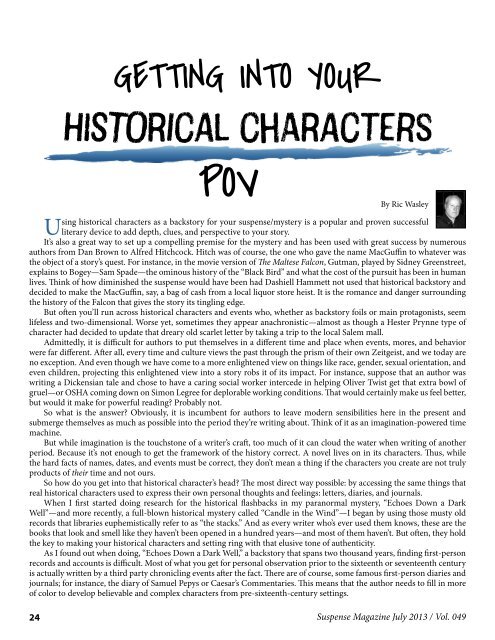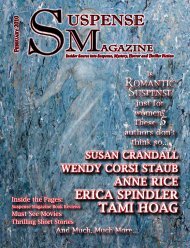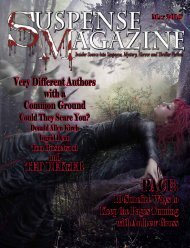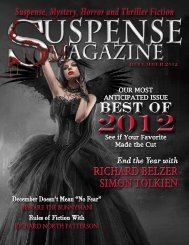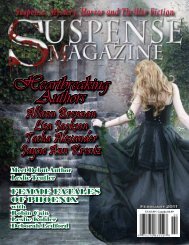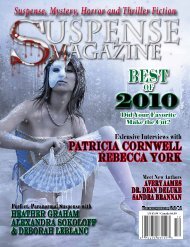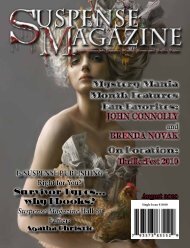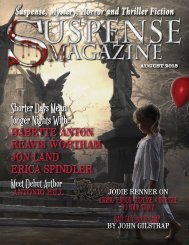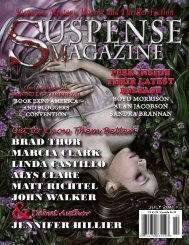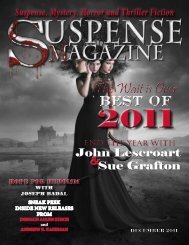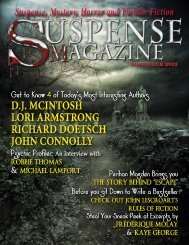Suspense Magazine July 2013
Suspense Magazine July 2013
Suspense Magazine July 2013
You also want an ePaper? Increase the reach of your titles
YUMPU automatically turns print PDFs into web optimized ePapers that Google loves.
Getting into your<br />
historical characters<br />
POV<br />
Using historical characters as a backstory for your suspense/mystery is a popular and proven successful<br />
literary device to add depth, clues, and perspective to your story.<br />
It’s also a great way to set up a compelling premise for the mystery and has been used with great success by numerous<br />
authors from Dan Brown to Alfred Hitchcock. Hitch was of course, the one who gave the name MacGuffin to whatever was<br />
the object of a story’s quest. For instance, in the movie version of The Maltese Falcon, Gutman, played by Sidney Greenstreet,<br />
explains to Bogey—Sam Spade—the ominous history of the “Black Bird” and what the cost of the pursuit has been in human<br />
lives. Think of how diminished the suspense would have been had Dashiell Hammett not used that historical backstory and<br />
decided to make the MacGuffin, say, a bag of cash from a local liquor store heist. It is the romance and danger surrounding<br />
the history of the Falcon that gives the story its tingling edge.<br />
But often you’ll run across historical characters and events who, whether as backstory foils or main protagonists, seem<br />
lifeless and two-dimensional. Worse yet, sometimes they appear anachronistic—almost as though a Hester Prynne type of<br />
character had decided to update that dreary old scarlet letter by taking a trip to the local Salem mall.<br />
Admittedly, it is difficult for authors to put themselves in a different time and place when events, mores, and behavior<br />
were far different. After all, every time and culture views the past through the prism of their own Zeitgeist, and we today are<br />
no exception. And even though we have come to a more enlightened view on things like race, gender, sexual orientation, and<br />
even children, projecting this enlightened view into a story robs it of its impact. For instance, suppose that an author was<br />
writing a Dickensian tale and chose to have a caring social worker intercede in helping Oliver Twist get that extra bowl of<br />
gruel—or OSHA coming down on Simon Legree for deplorable working conditions. That would certainly make us feel better,<br />
but would it make for powerful reading Probably not.<br />
So what is the answer Obviously, it is incumbent for authors to leave modern sensibilities here in the present and<br />
submerge themselves as much as possible into the period they’re writing about. Think of it as an imagination-powered time<br />
machine.<br />
But while imagination is the touchstone of a writer’s craft, too much of it can cloud the water when writing of another<br />
period. Because it’s not enough to get the framework of the history correct. A novel lives on in its characters. Thus, while<br />
the hard facts of names, dates, and events must be correct, they don’t mean a thing if the characters you create are not truly<br />
products of their time and not ours.<br />
So how do you get into that historical character’s head The most direct way possible: by accessing the same things that<br />
real historical characters used to express their own personal thoughts and feelings: letters, diaries, and journals.<br />
When I first started doing research for the historical flashbacks in my paranormal mystery, “Echoes Down a Dark<br />
Well”—and more recently, a full-blown historical mystery called “Candle in the Wind”—I began by using those musty old<br />
records that libraries euphemistically refer to as “the stacks.” And as every writer who’s ever used them knows, these are the<br />
books that look and smell like they haven’t been opened in a hundred years—and most of them haven’t. But often, they hold<br />
the key to making your historical characters and setting ring with that elusive tone of authenticity.<br />
As I found out when doing, “Echoes Down a Dark Well,” a backstory that spans two thousand years, finding first-person<br />
records and accounts is difficult. Most of what you get for personal observation prior to the sixteenth or seventeenth century<br />
is actually written by a third party chronicling events after the fact. There are of course, some famous first-person diaries and<br />
journals; for instance, the diary of Samuel Pepys or Caesar’s Commentaries. This means that the author needs to fill in more<br />
of color to develop believable and complex characters from pre-sixteenth-century settings.<br />
By Ric Wasley<br />
24 <strong>Suspense</strong> <strong>Magazine</strong> <strong>July</strong> <strong>2013</strong> / Vol. 049


